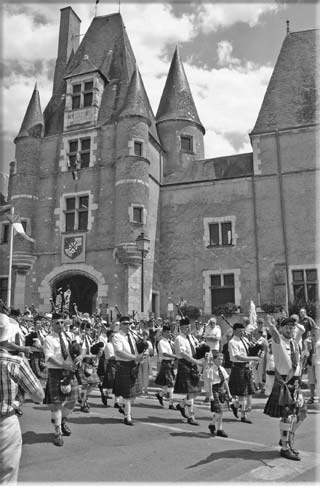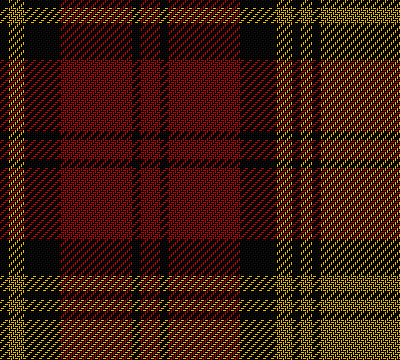|
I wonder how many Scots know
that there is a town in France that's more Scottish than many towns in
Scotland.
It all goes back to 1419 during the Hundred Years War. The French dauphin,
later to become Charles VII, was struggling against the English in nearby
Bourges and appealed to Scotland for assistance. Always willing to do battle
against the Sassenachs, an army of some ten thousand Scots made its way to
Bourge and eventually the war swung in favour of the French. As the war had
drained his finances, the dauphin handed over the town of Aubigny to the
leader of the Scots, John Stuart of Darnley, as payment for his assistance.
The Stuart family were highly influential in Aubigny and its surrounding
area for many years until the line eventually died out and the whole affair
became forgotten in history. However, in 1931 the Scottish connection was
brought to the surface once again in the shape of a festival and has been
celebrated since then. The town's hotel is named the Cutty Sark and there is
an Aubigny tartan, worn regularly by many of the male inhabitants of the
town, several of whom play in the town's pipe band.
Aubigny is twinned with Haddington in East Lothian and I'm sure that someone
from Haddington would shed much more light on this wonderful example of the
Auld Alliance than the few lines that I have scribbled.
Regards
George Wilkie
In time many Scots settled in
Aubigny, setting up cloth and glass industries, while the Stuarts themselves
continued to live there for more than 200 years.
Disaster struck in 1512 when most of the town was destroyed by fire, but the
then Stuart incumbent, Robert, allowed trees from his estate to be used in
the rebuilding and it is from this period that many of the half-timbered
houses date. It is said that it took the wood from three of the five forests
on his estate to complete the restoration...
 The
temperature is in the low 30s. Hardly a heatwave, but just hot enough to
banish rash thoughts of any serious physical effort. Better just to sit here
on the terrasse and enjoy a glass of chilled petit gris (Sancerre rosé)
while contemplating the aroma of haggis grilling slowly to mouth-watering
perfection on the barbecue. The
temperature is in the low 30s. Hardly a heatwave, but just hot enough to
banish rash thoughts of any serious physical effort. Better just to sit here
on the terrasse and enjoy a glass of chilled petit gris (Sancerre rosé)
while contemplating the aroma of haggis grilling slowly to mouth-watering
perfection on the barbecue.
At the far
end of the street, pipers tune up, in a shrill Celtic cacophony. Gradually,
the anarchic whines become a low musical hum. A crisp clear roll on a snare
drum brings the pipes to order. The first notes of ‘Scotland the Brave’ ring
out loud and proud across Aubigny-sur-Nère.
Welcome to
the Fêtes Franco-Écossaises – the best of Scotland in the heart of rural
France. However, if you believe Aubigny’s deputy mayor François Gresset, we
are technically not in France but in a small, far-flung corner of Scotland.
“Aubigny,
or Albany as the Scots called it, was given to John Stuart, Lord Darnley by
Charles VII of France, for services rendered during the Hundred Years’ War.
Both Scotland and France had signed a mutual defence pact in 1295, which
became known as the ‘Auld Alliance’. In 1419, Charles VII, who was still
Dauphin, had withdrawn to Bourges, about the only part of France that was
still French. English, Armagnac and Burgundian armies hemmed him in. He
called on the Scots for help under the terms of the alliance. In 1419,
Scottish archers and men at arms started to land at La Rochelle. At first
there were only a few hundred.
“Over the
following six years, 17,000 Scottish troops arrived in France. In 1421, John
Stuart of Darnley landed at La Rochelle with 5,000 troops and marched
straight to the town of Baugé in the Anjou to help the French. In the
ensuing battle, a combined army of French and Scottish soldiers routed an
English army almost twice their size. The victory was made even sweeter when
it was learned that the Duke of Clarence, Henry V’s brother, had been killed
in the battle.
“At the
time, the French monarchy was hard up, so the only way to reward the Scots
was by giving them land. John Stuart of Darnley was given Aubigny. The town
and surrounding lands were to be his possessions forever, passing down
through the generations to the next male heir. As Duke of Aubigny, Darnley
entered the French nobility.
“Since
then, Aubigny has played a substantial part in French and Scottish history.
Mary Queen of Scots was betrothed in the castle here, and when Charles II
became king of England, he got Louis XIV to give Aubigny to his French
mistress Louise de Keroualle. The fruit of Charles’ illicit union was a
certain Charles Lennox, who later became the Duke of Richmond, a direct
ancestor of the late Lady Diana. Technically, this makes Prince William
claimant to the title of Duke of Aubigny.”
At first
glance, there’s not much Scottish about Aubigny, a quaint half-timbered,
picture-postcard town on the edge of the Sologne, without an austere grey
Scottish stone in sight. However, the good citizens of Aubigny have their
own pipe band, their own tartan (Stuart hunting) and even their own whisky,
though that is actually made in Scotland and shipped over.
In the
early 90s, the maire of Aubigny Yves Fromion decided that something had to
be done to celebrate Aubigny’s Scottish connexion. He hit upon the idea of
the Fêtes Franco-Écossaises.
This
year’s Franco- Scottish festivities run from July 8 to 16. As usual, there
will be parades of Scottish pipe bands, a Highland Games to celebrate
Bastille Day, a huge brocante and a vast son et lumière (sound and light)
portraying Aubigny’s history.
Visiting
Scots (and Sassenachs) are cordially invited to take part though, laughs
François Gresset, the Scots have never actually left Aubigny: “Just take a
quick glance through the local phone book – it’s full of Scots: Archer,
Archambault, Bailly, Baillard and Baillieul, all names of Scottish origin,
all still going strong in the Berry.”

Aubigny Auld Alliance District tartan |

